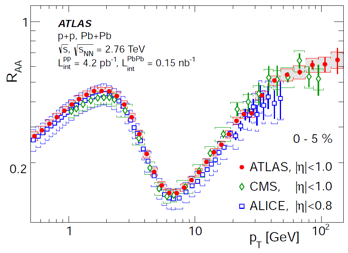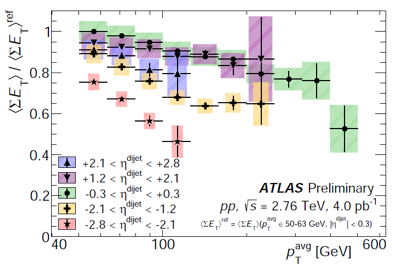ATLAS results from lead-lead and proton-lead collision
The ATLAS results from PbPb data included a measurement of high-pΤ photons and W mesons, high-precision measurement of jet and charged particle RΑΑ, studies of jet fragmentation, path length dependence of jet quenching, neighbouring jet production and studies of flow and correlations of low pΤ particles. The pPb results included the measurement of Z boson, J/ψ, Ψ(2S), the measurement of jet production and jet fragmentation. Further, the measurement of the correlation between jet production and the underlying event in pp collisions was presented which should improve the understanding of the interplay between soft processes and hard processes in pPb. Here are few selected highlights of the presented results.
A strong jet quenching at LHC was seen shortly after the first heavy ion collisions in 2010 in the measurement of large dijet asymmetry. Following this observation, a group of measurements aims to better understand the in-medium path length dependence of jet quenching. The first measurements of the azimuthal dependence of inclusive jet yields showed significant variation of inclusive jet suppression as a function of relative azimuthal angle, ΔΦ, with respect to the interaction plane.
The jet yields were observed to vary by as much as 20% between the directions pointing towards and out of the interaction plane. Motivated by this measurement, ATLAS has performed a similar analysis for the dijets. The dijet asymmetry, AJ, was studied for different angles that the leading-jet makes with respect to the interaction-plane angle. These measurements effectively study the path-length dependence of the dijet asymmetry by requiring the jet pair to traverse different lengths of the medium. The dependence of the AJ on the interaction-plane angle was quantified by calculating the second Fourier coefficient of the AJ azimuthal distribution, termed c2. As shown in Figure 1, the measured c2 signal is quite small (≤ 2%), however, it is consistently negative, indicating a slightly larger asymmetry when the dijet pair is oriented out-of-plane than in-plane.

Figure 1: The c2, the second Fourier coefficient of the azimuthal distribution of dijet asymmetry, shown as a function of centrality. The vertical grey bands indicate systematic uncertainties and the vertical bars indicate statistical errors. The shaded bands indicate the statistical and systematic uncertainties added in quadrature. The three panels correspond to three jet-radius parameters, as indicated in the plots. Lines show fits to the constant function.
This measurement was further extended by repeating the analysis when constraining the shape of the collision geometry by selecting events based on the magnitude of the second-order flow harmonic quantified by the magnitude of the q2 vector. Within a given centrality interval, events with large q2 (i.e. events with more elliptic geometry, show an increase in the c2 for the 20-30% and 30-40% centrality bins.). This measurement together with the original measurement of the azimuthal dependence of inclusive jet yields and the measurement of neighbouring jet suppression can provide significant constrains on the energy loss mechanism of hard scattered partons and its in-medium path length dependence.
ATLAS, has also delivered precise measurements of the nuclear modification factor (a measurement used for studying jet quenching) of inclusive charged particles at high-pT that is shown together in Fig.2. The RAA was also measured as function of the pseudorapidity being consistent with flat pseudorapidity dependence over the whole transverse momentum range in all centrality bins. This striking behaviour together with the RAA at high-pT should also provide significant constrains on the energy loss modelling.

Figure 2: The RΑΑ of charged particles measured as a function of pT in the centrality interval 0-5%. The ATLAS and CMS results correspond to the pseudorapidity range |η| < 1, the ALICE results to |η| < 0.8. Statistical uncertainties are shown with vertical bars and systematic uncertainties with brackets.
One of the striking features seen in pPb collisions is the centrality dependence of the nuclear modification factor of inclusive jets, RpPb, which shows a suppression of the jet yield in central events and an enhancement in peripheral events. In pPb collisions, the centrality is estimated in forward calorimeters in the direction of the lead beam. The effects seen in RpPb of jets imply that the factorization between hard and soft processes is violated at an unexpected level in pPb collisions.
To improve the understanding of soft-hard correlations ATLAS measured the relationship between jet production and the underlying event in a pseudorapidity separated region in 2.76 TeV pp collisions. In that study, the underlying event was characterized through measurements of the average sum of the transverse energy at large negative pseudorapidity, <ΣET>, which were reported as a function of hard scattering kinematic variables. The hard scattering was characterized by the average transverse momentum and pseudorapidity of the two highest transverse momentum jets in the event. It was found that the <ΣET> is anticorrelated with the dijet pT, decreasing by 25% as pT varies from 50 to 500 GeV.
A result is shown in Figure 3. The measurement was repeated as a function of Bjorken-x of the target and projectile nucleons, where target is defined to be heading towards the negative pseudorapidity. It was found that the average level of transverse energy production is sensitive predominantly to the Bjorken-x of the target proton. These results measured in pp collisions provide useful context for understanding the results from p-Pb collisions implying that jets formed during these collisions are not due to trivial anticorrelation in individual nucleon-nucleon collisions (i.e. effects from the energy conservation).

Figure 3: Normalized total transverse energy at large negative pseudorapidity, <ΣET>/<ΣETref>, characterizing the underlying event evaluated as a function of dijet pT for different dijet pseudorapidity selections. The shaded bands represent the total systematic and statistical uncertainties in quadrature while the vertical error bars represent statistical uncertainties only.
Further reading: https://twiki.cern.ch/twiki/bin/view/AtlasPublic/HeavyIonsPublicResults
